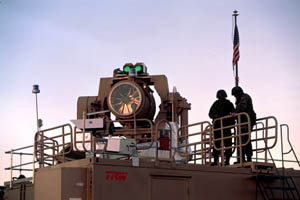We are developing the social individualist meta-context for the future. From the very serious to the extremely frivolous... lets see what is on the mind of the Samizdata people.
Samizdata, derived from Samizdat /n. - a system of clandestine publication of banned literature in the USSR [Russ.,= self-publishing house]
|
Last hurrah for the caissons The laser testbed at White Sands has racked up yet another first. It has shot down an artillery shell in flight:
“This shootdown shifts the paradigm for defensive capabilities. We’ve shown that even an artillery projectile hurtling through the air at supersonic speed is no match for a laser,” said Army Lt. Gen. Joseph Cosumano, head of the missile defense command.
You can find out more about it here.
 Tactical High Energy Laser Director.
Tactical High Energy Laser Director.
Photo © TRW Inc. 2000. All Rights Reserved. Republished by kind permission of TRW Inc
|
Who Are We? The Samizdata people are a bunch of sinister and heavily armed globalist illuminati who seek to infect the entire world with the values of personal liberty and several property. Amongst our many crimes is a sense of humour and the intermittent use of British spelling.
We are also a varied group made up of social individualists, classical liberals, whigs, libertarians, extropians, futurists, ‘Porcupines’, Karl Popper fetishists, recovering neo-conservatives, crazed Ayn Rand worshipers, over-caffeinated Virginia Postrel devotees, witty Frédéric Bastiat wannabes, cypherpunks, minarchists, kritarchists and wild-eyed anarcho-capitalists from Britain, North America, Australia and Europe.
|





My tax $ hard at work. Let’s hope it keeps working.
Consider it’s use for point air defense. I’d bet that in ten years the Pentagon and other high value soft targets are defended by these.
I don’t think an airliner would make it through the gauntlet, and the reaction time required is far, far less than ground to air AA missiles.
I unfortuneately also foresee a day when tall buildings have private air defense of this sort. Blowing an airliner up before impact disperses the kinetic energy and ignites the fuel outside. Innocents in plane and building still die, but not so many as with a fuel-air explosion after deep penetration.
I think the laser is going to spell the end for the air forces of countries that don’t have it. Between ground based weapons like THEL and the Air Force’s ABL, which will fly about zapping everything airborne that’s hostile as soon as it’s detected and identified, I don’t see how aircraft will stand a chance.
Further, cruise and ballistic missiles may well become similarly useless. The only way ballistic missiles will remain a threat is to have a Soviet style force of many thousands each with MIRVs.
Microwave weapons are also coming into use. The age of energy beam weapons is upon us, and I believe it will be a revolution comparable to gunpowder.
It will certainly cause drastic changes in hardware design and in tactics.
Static forts become viable again. I can imagine hill top fortresses studded with laser turrets.
Artillery shells, missiles and bombs will become much less effective. Bombs are perhaps the least affected because they can carry a great deal of armour, whereas the same solution kills the economics of artillery shells unless we go back to cannonballs; and battlefield tactical missiles are pretty much done for.
Speed doesn’t matter much for aircraft in this environment; what matters is armour. So you end up with literal flying fortresses.
Initially “small” fast jets will be okay, but in the long run they will be at a disadvantage as offense/defense forces an upward spiral in Energy levels.
Lasers are stricly line of sight, so you have to slug it out with your enemy. One imagines Leviathans of the air battering away at a hill fort like in old style naval battles.
We might be back to armour and set piece battles…
Like in so many other fields, in weaponry evolution early comparative advantage can sometimes become almost insurmountable as time goes on. I think that not only will ultra-advanced weaponry like lasers will come to quickly dominate the battlefield, but very few states will be able to afford the weapons themselves much less afford all the associated operating costs, still less afford the sort of armed forces you need to effectively field such weapons. It’s getting harder and harder for those behind the bleeding edge to keep up.
What we may see is a handful of states (US and select allies, maybe China) acquiring an uncontestable conventional military dominance for the forseeable future, even more so than what is the case now.
How much energy to destroy 1 shell? how is it destroyed? boiled away? the explosive ignited? how long is the pulse that destroys the shell? microseconds? nanoseconds? I think it will be a long time before a laser can take out a large barrage of shiny shells converging on it, especially if the shells that are hit throw off a lot of smoke. How difficult would it be to arrange for guided missiles to dodge and weave on their way to the target ? what aims the laser? radar? another laser? can it be blinded or spoofed? The geniuses of the uk government scrapped the whole military aircraft industry because the missile had made all aircraft redundant in the sixties (fifties?). I will believe it when it proves itself against real adversaries.
Payed for by the theft of our money, this is a disgrace.
If you think a first rate army is too expensive, consider how expensive a second rate one is likely to be.